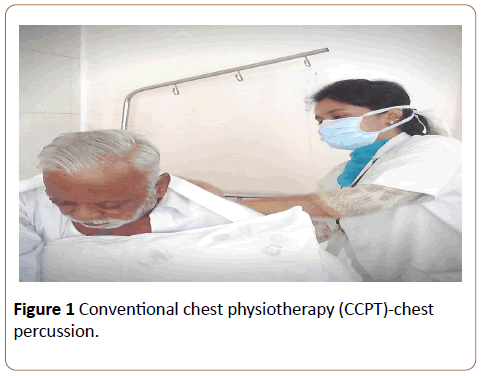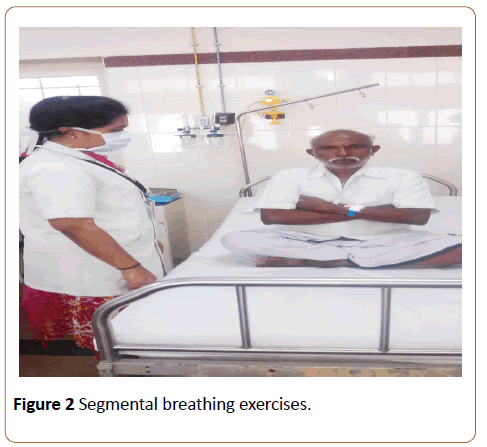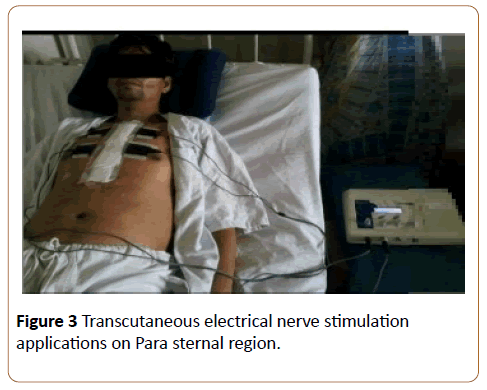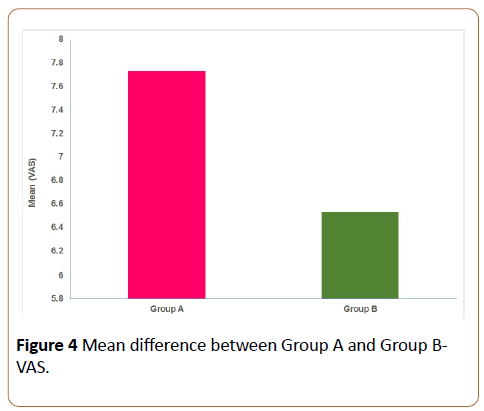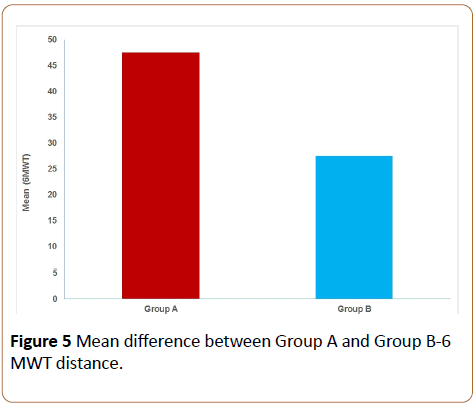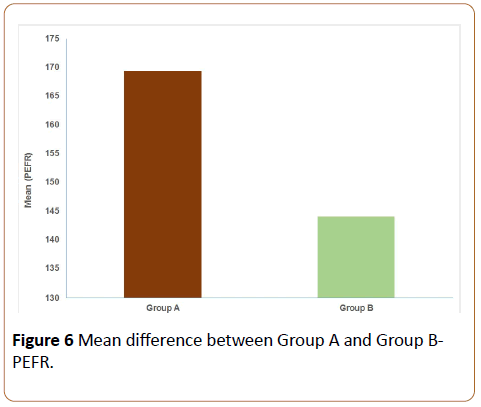Efficacy of TENS and Respiratory Physiotherapy to Improve Functional Capacity in Post CABG Patients
Monisha R1* and Aparna Krishnakumar2
1SRM College of Physiotherapy, SRM University, Chennai, Tamil Nadu, India
2Narayana Hrudayalaya Institute of Cardiac Sciences, Banglore, India
- *Corresponding Author:
- Monisha R
SRM College of Physiotherapy
SRM University, Chennai, Tamil Nadu
India
Tel: 044-27417833
E-mail: monisha.r@ktr.srmuniv.ac.in
Received date: November 02, 2017; Accepted date: November 15, 2017; Published date: November 25, 2017
Citation: Monisha R, Krishnakumar A. Efficacy of TENS and Respiratory Physiotherapy to Improve Functional Capacity in Post CABG Patients. J Physiother Res. 2017, Vol.1 No.2:8.
Copyright: © 2017 Monisha R, et al. This is an open-access article distributed under the terms of the Creative Commons Attribution License, which permits unrestricted use, distribution, and reproduction in any medium, provided the original author and source are credited.
Abstract
Background: Coronary Artery Bypass Grafting (CABG) is the most common surgery performed in the world for Coronary Artery Disease. It is a life-saving procedure which is frequently related to significant postoperative pain. Objectives: The purpose of the study is to analyze the effect of TENS and respiratory physiotherapy in functional improvement on post CABG patients. Need for the study: Pain is a common symptom felt during postoperative period at the incision site, which might interfere with pulmonary function and healing. A number of lung defence mechanisms may become impaired, or overtly ineffective, due to intense chest pain. Although narcotics and opiates may be effective for pain control, they are associated with side effects, including respiratory depression. Therefore, there is a long-standing interest in the development of non-chemical strategies for effective pain control Methodology: Total number of 30 patients was selected for the study. Out of 30 patients 15 were assigned into two groups, Group A received conventional chest physiotherapy along with TENS and Group B received conventional chest physiotherapy alone. This study was carried out for a period of 12 weeks. Daily 40 minutes for 10 days and the values of the parameters selected were assessed on the 2nd post-operative day and 10thpostoperative day. Conclusion: The outcome of the data collection reveals that the application of TENS plays a vital role in the reduction of pain in patients with CABG. The recordable change shows in visual analogue scale, six-minute walk test and peak expiratory flow rate. Keywords: TENS; CABG; Pain; Functional improvement; Respiratory physiotherapy Background The efficacy of physiotherapy techniques used for patients following coronary artery bypass surgery (CABG) is well documented. It is a life-saving procedure which is frequently related to significant postoperative pain. Many lung defense mechanisms may become impaired, or overtly ineffective, due to intense chest pain. Although narcotics and opiates may be effective for pain control, they are associated with side effects, including respiratory depression. Therefore, there is a longstanding interest in the development of non-chemical strategies
Keywords
TENS; CABG; Pain; Functional improvement; Respiratory physiotherapy
Background
The efficacy of physiotherapy techniques used for patients following coronary artery bypass surgery (CABG) is well documented. It is a life-saving procedure which is frequently related to significant postoperative pain. Many lung defense mechanisms may become impaired, or overtly ineffective, due to intense chest pain. Although narcotics and opiates may be effective for pain control, they are associated with side effects, including respiratory depression. Therefore, there is a longstanding interest in the development of non-chemical strategies for effective pain control. Cardiac and abdominal surgery are associated with an occurrence of pulmonary complications (PC), defined as any pulmonary abnormality that occurs during the postoperative period which produces identifiable disease or dysfunction that is clinically significant, and which adversely affects the clinical course [1]. Transcutaneous electrical nerve stimulation (TENS) has been used as an adjunctive therapy for chronic and acute pain control. It has also been shown to be effective in the postoperative period of cardiac and non-cardiac thoracic surgery. It is a form of electrical stimulation with surface electrodes which are used to modulate pain perception [2]. However, the positive effects of TENS have not been uniformly reported: some researchers found that TENS was not effective in all patients, especially in those with more intense pain. In addition, decline on pulmonary-ventilatory function was not always lessened after TENS. Therefore, the actual role of TENS in controlling post-CABG pain and its undesirable consequences is still controversial1. Respiratory physiotherapy is regularly used to prevent or reduce pulmonary complications following heart surgery. Postoperative breathing exercises, combined with physical therapy after coronary artery bypass graft (CABG) surgery, have been reported to be as effective as physical therapy, including early mobilization on its own, in reducing atelectasis, pneumonia, or other types of pulmonary complications [3]. Pain is a common symptom felt during postoperative period at the incision site, which might interfere with pulmonary function and healing. Respiratory complications are the most common complications that may occur in postoperative period which typically develops during the first 48 hours after the surgery. Anesthesia and tissue dissection during CABG contribute to changes in lung volumes and gas exchange. Because of anesthesia the motility of the cilia reduces and causes retaining secretions, thereby causing atelectasis. Reduction in functional capacity has implications for postoperative complications and the course of recovery [4]. Therefore an early pain reduction helps to keep the patient relieved from the adverse effects of analgesia, cough, and thereby helps to speed up the recovery.
Methodology
Study design
Pre-test and post-test experimental study design.
Sample size
Total number of 60 patients was selected for the study. 30 of them were excluded for various reasons. Out of 30 patients 15 were assigned to each group.
Treatment duration
Daily 40 minutes for 10 days and the values of the parameters selected were assessed on the 2nd post-operative day and 10th post-operative day.
Selection criteria
Inclusion criteria:
• 55 to 60 years.
• Undergoing CABG through Median Sternotomy.
• Showing a rate equal to or greater than 3 in VAS of pain.
• Male patients were included.
• Patient who are willing to participate in the study.
Exclusion criteria:
• Female patients were excluded.
• Patients with cognitive deficit.
• Central or peripheral neurological sequelae.
• With painful symptoms of undiagnosed cause.
• Presence of metallic implants.
• Pacemaker patients undergoing CABG by Thoracotomy.
• Patients with local infection.
• Patients with post-operative complications like-Prolonged drainage, Increased body temperature, Respiratory tract infection.
Assessment parameters
The following parameters were assessed for analysis of the outcome.
• Visual Analogue Scale.
• 6 Minute Walk Test.
• Peak Expiratory Flow Rate.
Study protocol:
Group A: (Experimental group)
TENS-Parameters:
Pulse form - Monophasic or biphasic.
Pulse width - 0.01 to 0.4 ms.
Frequency - 50 to 200 Hz.
Intensity - up to 30 MA, or till a tingling sensation is felt.
Conventional Chest Physiotherapy (CCPT)
• Deep Breathing Exercises (Figures 1-3).
(a)Diaphragmatic Breathing Exercise.
(b)Segmental Breathing Exercise.
• Lung expansion exercises.
• Secretion removal maneuvers.
(a) Percussion
(b) Vibration
(c) Shaking
• Assisted Coughing.
Data analysis and interpretation
Independent “t” test was used to show the effectiveness of treatment between group A and group B. The “t” value was calculated using the formula (Table 1, Figures 4-6).
| Parameters | Group | Mean | SD | ‘t’ value |
|---|---|---|---|---|
| Visual Analogue Scale | Group A | 7.73 | 0.961 | 3.367 |
| Group B | 6.53 | |||
| 6 Minutes’ Walk Test Distance | Group A | -47.53 | 17.083 | -3.83 |
| Group B | -27.47 | |||
| Peak Expiratory Flow Rate | Group A | -169.3 | 45.166 | -1.433 |
| Group B | -144 |
Table 1: Mean difference between Group A and Group B.


Discussion
The purpose of the study is to determine “efficacy of Transcutaneous Electrical Nerve Stimulation and Respiratory Physiotherapy on functional improvement in post CABG patients.” The study was conducted out for a period of 12 weeks. Pain has been pointed out as one of the chief concerns of patients following CABG. A widely accepted view is that pain is known to restrict effective coughing, deep breathing and early post-operative mobilization [5]. In the present study, it was found that conventional chest physiotherapy including deep breathing exercise, lung expansion exercise, secretion removal maneuvers, assisted coughing and TENS significantly decrease atelectasis and improved PEF rate, six-minute walk test distance and VAS score compared to a regime without TENS application following CABG surgery. Atelectasis was decreased in experimental group compared to the control group. In our study PEF rate, 6MWT distance and VAS measurement was performed post operatively on 2nd POD and repeated on the 10th POD. The patients were encouraged to perform the deep breathing exercises. The frequency (3 sets of 10 breaths) was chosen [6-9]. In our study all patients in the experimental group found the breathing technique easy to perform following TENS application and most of the patients experienced a subjective benefit of the exercises; this is important for completion of the treatment. The results in various parameters were compared.
In VAS, 6 patients of them in group A had maximal improvements and the remaining 9 patients had a moderate improvement. The average value is 7.73. For group B, 4 patients had maximal improvement and 4 patients had minimal improvements and the remaining 7 patients had a moderate improvement. The average value is 6.53 and the standard deviation is 0.961 and the t value is 3.367 at 0.05 level of significance [10-14].
In 6MWT, 5 patients of them in group A had maximal improvements and 1 patient had a minimal improvement and others had a moderate improvement. The average value is -47.53. For group B, 6 patients had a moderate improvement and the remaining had a minimal improvement. The average value is -27.47 and the standard deviation is 17.083 and t value is -3.830 at 0.05 level of significance.
In PEFR, 8 patients of them in group A had maximal improvements and others had a moderate improvement [15-17]. The average value is -169.33. For group B, 11 patients had a moderate improvement and the others had minimal improvement. The average value is -144.00 and the standard deviation is 45.166 and t value is -1.433 at 0.05 level of significance. Hence group A showed better outcome than group B [18-20].
Conclusion
The outcome of the data collection reveals that the application of TENS plays a vital role in the reduction of pain in patients with CABG. The recordable change shows in visual analogue scale, six-minute walk test and peak expiratory flow rate. There is significant difference between the effects of Transcutaneous Electrical Nerve Stimulation and Respiratory Physiotherapy on functional improvement in post CABG patients.
References
- Cipriano Jr G, Camargo Carvalho AC, Bernardelli GF, Tayar Peres PA (2008) Short-term transcutaneous electrical nerve stimulation after cardiac surgery: effect on pain, pulmonary function and electrical muscle activity. Interactive cardiovascular and thoracic surgery 7: 539-543.
- Chandra A, Banavaliker JN, Das PK, Hasti S (2010) Use of transcutaneous electrical nerve stimulation as an adjunctive to epidural analgesia in the management of acute thoracotomy pain. Indian journal of anaesthesia 54: 116.
- Yánez-Brage I, Pita-Fernández S, Juffé-Stein A, Martínez-González U, Pértega-Díaz S,et al. (2009) Respiratory physiotherapy and incidence of pulmonary complications in off-pump coronary artery bypass graft surgery: an observational follow-up study. BMC pulmonary medicine 9: 36.
- Karcz M, Papadakos PJ (2013) Respiratory complications in the postanesthesia care unit: A review of pathophysiological mechanisms. Canadian journal of respiratory therapy: CJRT= Revue canadienne de la therapie respiratoire: RCTR 49: 21.
- Biplab N, Sucheta M, Ujwal Y, Pravin G, Roshan A (2015) Effectiveness Of Incentive Spirometry In Improving Peak Expiratory Flow Rate In Post Abdominal Surgery : An Experimental Study journal of medical thesis 3: 15-18.
- Bayindir O, Paker T, Akpinar B, Erenturk S, Askin D, et al. (1991) Use of transcutaneous electrical nerve stimulation in the control of postoperative chest pain after cardiac surgery. Journal of cardiothoracic and vascular anesthesia 5: 589-591.
- Forster EL, Kramer JF, Lucy SD, Scudds RA, Novick RJ (1994) Effect of TENS on pain, medications, and pulmonary function following coronary artery bypass graft surgery. Chest 106: 1343-1348.
- Siafakas NM, Mitrouska I, Argiana E, Bouros D ( 1999) Effects of surgery on the function of the respiratory muscles. Monaldi archives for chest disease= Archivio Monaldi per le malattie del torace 54: 526-531.
- Yan Q, Sun Y (1996) Quantitative research for improving respiratory muscle contraction by breathing exercise. Chinese medical journal 109: 771-775.
- DeLoach LJ, Higgins MS, Caplan AB, Stiff JL (1998) The visual analog scale in the immediate postoperative period: intrasubject variability and correlation with a numeric scale. Anesthesia & Analgesia 86: 102-106.
- Jenkins SC, Soutar SA, Loukota JM, Johnson LC, Moxham J (1989) Physiotherapy after coronary artery surgery: are breathing exercises necessary? Thorax 44: 634-639.
- Opasich C, De Feo S, Pinna GD, Furgi G, Pedretti R, et al. (2005) Distance Walked in the 6-Minute Test Soon after Cardiac Surgery: Toward An Efficient Use in the Individual Patient. Cardiopulmonary Physical Therapy Journal 16: 36.
- Pasquina P, Walder B (2003) Prophylactic respiratory physiotherapy after cardiac surgery: systematic review. Bmj 327: 1379.
- Tenling A, Hachenberg T, Tyden H, Wegenius G, Hedenstierna G (1998) Atelectasis and gas exchange after cardiac surgery. The Journal of the American Society of Anesthesiologists 89: 371-378.
- Vargas FS, Terra-Filho M, Hueb W, Teixeira LR, Cukier A, et al (1997) Pulmonary function after coronary artery bypass surgery. Respiratory medicine 91: 629-633.
- Ho A, Hui PW, Cheung J, Cheung C (1987) Effectiveness of transcutaneous electrical nerve stimulation in relieving pain following thoracotomy. Physiotherapy 73: 33-35.
- Yan Q, Sun Y (1996) Quantitative research for improving respiratory muscle contraction by breathing exercise. Chinese medical journal 109: 771-775.
- Jones AY, Hutchinson RC (1991) A comparison of the analgesic effect of transcutaneous electrical nerve stimulation and entonox. Physiotherapy 77: 526-30.
- Chuter TA, Weissman C, Mathews DM, Starker PM (1990) Diaphragmatic breathing maneuvers and movement of the diaphragm after cholecystectomy. 97: 1110-1114.
- Fields HL, Bonica JJ, Albe-Fessard DG, Dubner R, Cervero F (1985) Advances in Pain Research and Therapy. Raven Pr.
Open Access Journals
- Aquaculture & Veterinary Science
- Chemistry & Chemical Sciences
- Clinical Sciences
- Engineering
- General Science
- Genetics & Molecular Biology
- Health Care & Nursing
- Immunology & Microbiology
- Materials Science
- Mathematics & Physics
- Medical Sciences
- Neurology & Psychiatry
- Oncology & Cancer Science
- Pharmaceutical Sciences
